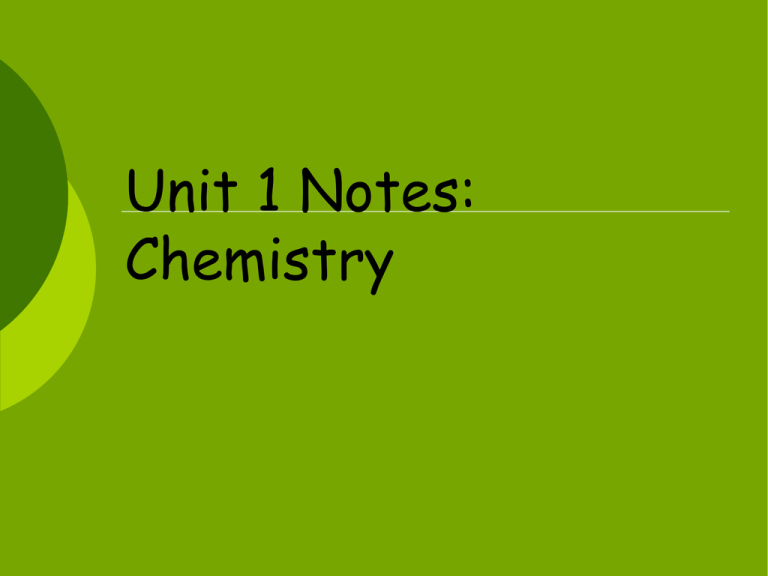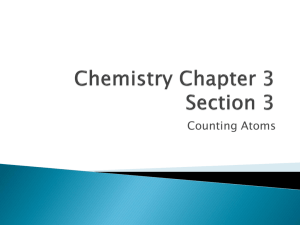Unit 1 Notes: Chemistry
advertisement

Unit 1 Notes: Chemistry All Biology consists of Chemistry All organisms are made up of matter. Matter is anything that takes up space and has mass. Matter is made up of one or more chemical elements. An element is a pure substance that cannot be broken down into any other substances. Elements There are about 25 different elements that are essential for life 4 main elements that make up the majority of living matter are; oxygen, carbon, hydrogen, and nitrogen. These make up 96% of living matter And then there are trace elements that are just as important for your body to function correctly, but they are found in very small amounts; iodine, iron. Trace elements make up less than 0.01% of your body! Compounds Compounds are substances that are made up of two or more elements. These elements are put together in specific ratios. For example, there are 2 hydrogen's needed for every oxygen in water (H2O) A compounds properties can be very different for the individual elements that it is made up of. Most compounds are made up of 3 or 4 different elements (C6H12O6) Atoms An atom is the absolute smallest part of an element. Atoms are made up of: Protons which have positive charges Electrons which are negatively charged Neutrons which are neutral They give an element its physical and chemical properties depending on how the protons, neutrons and electrons are arranged. Where are the parts of an atom found? In an atom you find the protons and neutrons in the nucleus, the electrons orbit around the nucleus in a “cloud”. All atoms of an element have the same atomic number or protons, it is the number of neutrons that can change. Isotopes An isotope is formed when an element has the same number of protons in the atom but changes numbers of neutrons in its nucleus. ***Adding a proton makes a new kind of atom, Adding a neutron makes an isotope of that atom and a heavier version of that atom Some elements can have quite a few different forms because there are several different numbers of neutrons found in nature. For example: Radioactive Isotope As more neutrons are added to the nucleus, the atom becomes unstable making the nucleus decay or give off energy. This matter and energy given off is radiation, which can be damaging, but also has many medical uses. An enriched form of water with an isotope of oxygen is the basis for PET scans to detect brain, heart, and abdominal cancers. An Electrons are important in chemical bonds! atoms structure and arrangement of electrons determines how that atom will react with another. When electron energy levels are not completely filled, the atoms are chemically reactive. The atoms want to have a filled energy level, so bonds are formed to make this happen. Bonds There are two types of bonds that we will talk about: 1. Ionic bonds-one atom transfers electrons to another atom This transfer makes the atom that has lost the electron positive and the atom that has gained the electron more negative The two atoms that have changed are know as ions. A positive ion=cation: A negative ion=anion. 2. Covalent bonds-two atoms share electrons. Two or more atoms held together by covalent bonds=molecule Chemical Reactions Atoms are constantly being rearranged by chemical reactions which can form new substances. This rearrangement can be easily seen in a chemical equation which is very much like a math equation. The starting material, or what goes into the reaction, are the reactants. The ending material, or how the reactants combine together, is known as the products. It is important to remember that chemical reactions do not create or destroy atoms, they only rearrange them. With this rearrangement there are new bonds forming and other bonds breaking. Elements are listed on the periodic table in an order based on number of protons. # protons = # electrons Why aren’t there the same amount of neutrons too? Because of isotopes! • Different number of neutrons can change the type of element. •Element Equations on Periodic Table *Number of Protons = Atomic Number *Number of Electrons = Number of Protons = Atomic Number *Number of Neutrons = Atomic Mass – Atomic Number How 36 How many electrons? 36 How many protons? many neutrons? 84 – 36 = 48 # protons = 42 # electrons = 42 # neutrons: 96 – 42 = 54 The Role of Carbon in Organisms A carbon atoms has 4 electrons available for bonding Has a great ability to bond with other atoms Large carbon compounds (thousands of carbon atoms) are called biomolecules EX: Proteins Polymer: large molecule formed when MANY smaller molecules bond together Carbohydrates Carbohydrates give energy to cells. Carbo-load before a big race? It really works! Carbohydrate: biomolecule of carbon, hydrogen, and oxygen EX: Monosaccharide (simple sugar): glucose, fructose. EX: Polysaccharide (many sugars): starch, glycogen, cellulose Going on a carb-free diet? Your body doesn’t need as many carbs as you give it on a daily basis because we store carbohydates! However, you still need carbs every day, your cells need their energy to keep you living. Lipids Lipids: large biomolecules made mostly of carbon and hydrogen with a small amount of oxygen. EX: fats, oils, waxes, and steroids. Don’t think about getting rid of lipids from your diet just yet! Cells use lipids for energy storage, insulation, and protective coverings. The major components of cell membranes are lipids Proteins Protein: large, complex polymer composed of carbon, hydrogen, oxygen and nitrogen. Proteins are essential to all life. Provide structure for tissues/organs and carry out everyday cell processes Amino Acids: basic building blocks of proteins About 20 common amino acids that we will cover in the DNA unit Ever hear of tryptophan on Thanksgiving? Enzymes Enzyme: protein that changes the rate of a chemical reaction. Enzymes are involved in nearly all metabolic processes. In some cases, enzymes speed up reactions that otherwise would be slow. EX: speed up digestion of food Enzyme activity depends on temperature and pH conditions.





